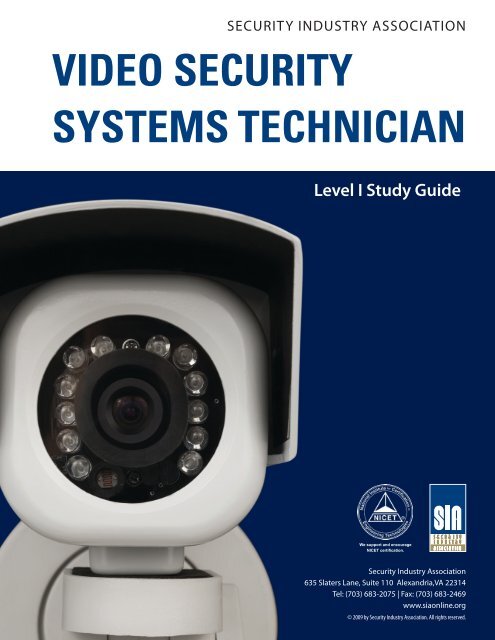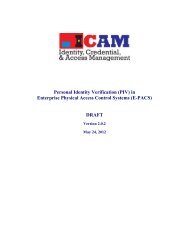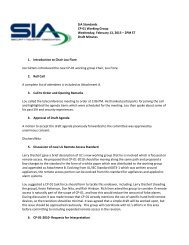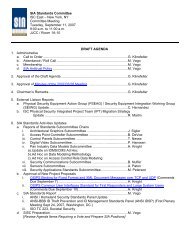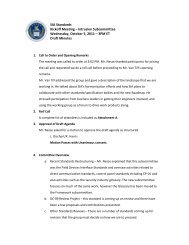Video Security SyStemS Technician - Security Industry Association
Video Security SyStemS Technician - Security Industry Association
Video Security SyStemS Technician - Security Industry Association
You also want an ePaper? Increase the reach of your titles
YUMPU automatically turns print PDFs into web optimized ePapers that Google loves.
<strong>Security</strong> <strong>Industry</strong> <strong>Association</strong><br />
<strong>Video</strong> <strong>Security</strong><br />
Systems <strong>Technician</strong><br />
Level I Study Guide<br />
We support and encourage<br />
NICET certification.<br />
<strong>Security</strong> <strong>Industry</strong> <strong>Association</strong><br />
635 Slaters Lane, Suite 110 Alexandria,VA 22314<br />
Tel: (703) 683-2075 | Fax: (703) 683-2469<br />
www.siaonline.org<br />
© 2009 by <strong>Security</strong> <strong>Industry</strong> <strong>Association</strong>. All rights reserved.
Study Guide for<br />
NICET <strong>Video</strong> <strong>Security</strong> Systems <strong>Technician</strong><br />
Level I Certification<br />
Prepared by<br />
Vlado Damjanovski, B.E.(electronics)<br />
and<br />
Howard Kohnstamm, VSS SME<br />
2009<br />
We support and encourage NICET certification.
2 NICET <strong>Video</strong> <strong>Security</strong> System <strong>Technician</strong> - Level I Study Guide ©2009 <strong>Security</strong> <strong>Industry</strong> <strong>Association</strong>. All rights reserved
Table of Contents<br />
<strong>Video</strong> <strong>Security</strong> Systems <strong>Technician</strong> VSST I .......................................................... 9<br />
INTRODUCTION<br />
BACKGROUND............................................................................................................................ 9<br />
ACKNOWLEDGMENT............................................................................................................... 9<br />
STRUCTURE & OVERVIEW...................................................................................................... 10<br />
VSST - VIDEO SECURITY SYSTEMS TECHNICIAN............................................................. 10<br />
VSSD - VIDEO SECURITY SYSTEMS DESIGNER................................................................. 10<br />
NICET VIDEO SECURITY SYSTEMS CLASSIFICATIONS.................................................... 11<br />
Type A Systems......................................................................................................................... 11<br />
Type B Systems......................................................................................................................... 11<br />
Type C Systems......................................................................................................................... 11<br />
VSST LEVEL I CERTIFICATION................................................................................. 13<br />
STANDARDS & PROFESSIONALISM.......................................................................... 15<br />
1. The Basic Principles of CCTV................................................................................................... 17<br />
Why use closed circuit television................................................................................................. 17<br />
Lenses............................................................................................................................................ 18<br />
Focal plane................................................................................................................................. 18<br />
For m at ....................................................................................................................................... 19<br />
Focal length............................................................................................................................... 19<br />
F-stop (iris opening).................................................................................................................. 21<br />
Irises......................................................................................................................................... 22<br />
.Fixed Iris.............................................................................................................................. 22<br />
.Manual Iris........................................................................................................................... 22<br />
.Motorized Iris....................................................................................................................... 22<br />
.Auto-Iris (<strong>Video</strong>-Drive & DC Drive)................................................................................ 22<br />
Depth of field............................................................................................................................. 24<br />
Focusing.................................................................................................................................... 25<br />
CCTV cameras.............................................................................................................................. 26<br />
3 NICET <strong>Video</strong> <strong>Security</strong> System <strong>Technician</strong> - Level I Study Guide ©2009 <strong>Security</strong> <strong>Industry</strong> <strong>Association</strong>. All rights reserved
Camera power supply................................................................................................................ 27<br />
V-phase or LL-phase ................................................................................................................ 28<br />
C/CS Mount.............................................................................................................................. 29<br />
Auto iris lens............................................................................................................................. 29<br />
Lens level.................................................................................................................................. 29<br />
Automatic Electronic Shutter (AES)......................................................................................... 30<br />
Frame integration...................................................................................................................... 31<br />
Back Light Compensation (BLC).............................................................................................. 31<br />
Wide Dynamic Range (WDR).................................................................................................. 31<br />
Automatic Gain Control (AGC)................................................................................................ 32<br />
Dynamic Noise Reduction (DNR)............................................................................................ 32<br />
Auto white balance (AWB) & Automatic track white (ATW).................................................. 32<br />
2. Assemble Camera Hardware and Place Assembled Camera on Mount ............. 33<br />
Fixed “box” cameras with separate lenses..................................................................................... 34<br />
Camera Mounts............................................................................................................................. 35<br />
Housings........................................................................................................................................ 36<br />
Fixed dome cameras with integral lenses...................................................................................... 37<br />
Camera installation checklist......................................................................................................... 38<br />
On the workbench.......................................................................................................................... 38<br />
On site............................................................................................................................................ 38<br />
3. Low Voltage Power Connections ........................................................................ 39<br />
NEC.......................................................................................................................................... 39<br />
.Class 1.................................................................................................................................. 39<br />
.Class 2.................................................................................................................................. 39<br />
.Class 3.................................................................................................................................. 39<br />
Understanding voltage and electric current............................................................................... 40<br />
Basic electrical units.................................................................................................................. 41<br />
.Volts...................................................................................................................................... 41<br />
.Amperes............................................................................................................................... 42<br />
.Ohms.................................................................................................................................... 43<br />
.Watts..................................................................................................................................... 44<br />
.Hertz..................................................................................................................................... 44<br />
4 NICET <strong>Video</strong> <strong>Security</strong> System <strong>Technician</strong> - Level I Study Guide ©2009 <strong>Security</strong> <strong>Industry</strong> <strong>Association</strong>. All rights reserved
.DC and AC voltage............................................................................................................... 44<br />
Electrical parallel and serial connections.................................................................................. 45<br />
Serial and Parallel Circuits........................................................................................................ 46<br />
Ohms law.................................................................................................................................. 48<br />
Power to the camera.................................................................................................................. 49<br />
Voltage drop calculations.......................................................................................................... 50<br />
Power supply capacity calculation............................................................................................. 51<br />
4. Make Low Voltage Splices and Junctions ........................................................... 53<br />
Low voltage splices and junctions............................................................................................. 54<br />
5. Coax and Twisted Pair Terminations .................................................................. 57<br />
Plenum and non-plenum cables................................................................................................. 57<br />
Coaxial cables........................................................................................................................... 58<br />
Impedance and minimum bending radius................................................................................. 60<br />
Types of coaxial cables and connectors.................................................................................... 61<br />
UTP Unshielded Twisted Pair................................................................................................... 64<br />
Category 5 and 6 cables............................................................................................................. 65<br />
6. Install Camera Mounts........................................................................................ 69<br />
Wood......................................................................................................................................... 69<br />
Metal......................................................................................................................................... 69<br />
Concrete.................................................................................................................................... 70<br />
7. Cabinets and Racks.............................................................................................. 73<br />
Cabinets..................................................................................................................................... 73<br />
EIA-310-D racks........................................................................................................................ 73<br />
8. System Testing and Commissioning Tasks.......................................................... 77<br />
System interconnecting diagram (Shop Plan)........................................................................... 77<br />
Verifying cables........................................................................................................................ 78<br />
<strong>Video</strong> signal levels..................................................................................................................... 79<br />
Power consumption................................................................................................................... 80<br />
5 NICET <strong>Video</strong> <strong>Security</strong> System <strong>Technician</strong> - Level I Study Guide ©2009 <strong>Security</strong> <strong>Industry</strong> <strong>Association</strong>. All rights reserved
9. Troubleshooting Tasks......................................................................................... 81<br />
Power cable troubleshooting...................................................................................................... 81<br />
<strong>Video</strong> cables troubleshooting.................................................................................................... 82<br />
10. Documentation Tasks......................................................................................... 83<br />
11. Temporarily Mark Cables for Construction ...................................................... 85<br />
12. Record Serial Numbers of Installed Devices .................................................... 87<br />
13. Recover and Store Equipment Documents ........................................................ 89<br />
14. Safe Work Site Practices.................................................................................... 91<br />
OSHA 2202 (Construction <strong>Industry</strong> Digest)............................................................................. 92<br />
Electrical installations............................................................................................................... 92<br />
Electrical work practices........................................................................................................... 93<br />
Ladders...................................................................................................................................... 93<br />
Laser......................................................................................................................................... 94<br />
Scaffolds, general requirements................................................................................................ 94<br />
Motor vehicles and mechanized Equipment ............................................................................. 95<br />
Storage....................................................................................................................................... 95<br />
OSHA 3080 (Hand and Power Tools)........................................................................................ 96<br />
Guard......................................................................................................................................... 97<br />
Electric tools.............................................................................................................................. 98<br />
Portable abrasive wheel T\tools ................................................................................................ 98<br />
<strong>Security</strong> and CCTV Systems specific hazards.......................................................................... 100<br />
15. Safe Voltage Electrical Practices........................................................................ 101<br />
Portable equipment.................................................................................................................... 103<br />
Protective equipment................................................................................................................. 103<br />
Conductive materials and equipment........................................................................................ 103<br />
De-energized parts.................................................................................................................... 103<br />
Energized parts.......................................................................................................................... 104<br />
6 NICET <strong>Video</strong> <strong>Security</strong> System <strong>Technician</strong> - Level I Study Guide ©2009 <strong>Security</strong> <strong>Industry</strong> <strong>Association</strong>. All rights reserved
Illumination............................................................................................................................... 104<br />
Portable ladders......................................................................................................................... 104<br />
Reclosing circuits...................................................................................................................... 104<br />
Vehicular and mechanical equipment near overhead power lines............................................. 104<br />
Electrical equipment/machinery............................................................................................... 104<br />
GFCI protection......................................................................................................................... 105<br />
Wiring....................................................................................................................................... 105<br />
NICET’s Practice Analysis Outlining Tasks Performed by the Level I Techs .... 107<br />
Level I Installer’s Toolkit......................................................................................... 113<br />
Hand tools:................................................................................................................................ 113<br />
Power tools................................................................................................................................ 113<br />
Specialty tools........................................................................................................................... 113<br />
Acronyms and Definitions of Terms and Codes Used in This Guide...................... 115<br />
About the Authors.................................................................................................... 119<br />
7 NICET <strong>Video</strong> <strong>Security</strong> System <strong>Technician</strong> - Level I Study Guide ©2009 <strong>Security</strong> <strong>Industry</strong> <strong>Association</strong>. All rights reserved
8 NICET <strong>Video</strong> <strong>Security</strong> System <strong>Technician</strong> - Level I Study Guide ©2009 <strong>Security</strong> <strong>Industry</strong> <strong>Association</strong>. All rights reserved
<strong>Video</strong> <strong>Security</strong> Systems <strong>Technician</strong> VSST I<br />
INTRODUCTION<br />
You might be relatively new to our important and increasingly high profile industry or you may already<br />
have years of experience and field knowledge. By participating in the NICET <strong>Video</strong> <strong>Security</strong> Systems<br />
program, you will be able to earn certifications that reflect your experience, knowledge and skills.<br />
NICET does not offer training. They offer certifications based upon successfully passing computer- based<br />
examinations and providing evidence of appropriate work experience for each level. The objective is<br />
to encourage candidates to constantly improve their job performance by obtaining additional knowledge,<br />
skills and abilities (KSA’s). The practice analysis for the <strong>Video</strong> <strong>Security</strong> Systems <strong>Technician</strong> outlining<br />
the specific KSA’s for Level I are at the end of this document.<br />
BACKGROUND<br />
The security industry has long sought to elevate the technical and professional competency of its<br />
technicians (service, install, etc.) and designers (sales, project managers, etc.). For manufacturers, higher<br />
levels of technical proficiency in the field mean lower tech support costs and product return rates. For<br />
installing dealers, it means lower installation and customer support costs. For end-users, it means better<br />
system performance. All of this results in a stronger, more vibrant CCTV industry.<br />
Although training is available from many sources including manufacturers, trade organizations and<br />
professional training companies, most people do not participate unless they need to satisfy a specific<br />
training requirement or have another compelling reason.<br />
The <strong>Security</strong> <strong>Industry</strong> <strong>Association</strong> (SIA) is an international nonprofit trade association representing<br />
electronic and physical security product manufacturers, specifiers and service providers. In 1999, a subcommittee<br />
of the SIA’s CCTV Interest Group initiated a certification program to create a compelling<br />
reason to participate in training and personal professional advancement. SIA chose the National Institute<br />
for Certification in Engineering Technologies (NICET) to administer this program. NICET is a non-profit<br />
organization dedicated solely to certification. They currently administer over thirty widely respected<br />
technical certification programs.<br />
With the help of SIA and and National Systems Contractors <strong>Association</strong>, NICET formed an advisory<br />
board of subject matter experts (SMEs) comprised primarily of installing dealers from large and small<br />
companies. The advisory board developed the practice analysis that was the basis for exam questions<br />
written by a larger group of SMEs. Another group of SMEs analyzed each of the questions for suitability<br />
and fairness.<br />
ACKNOWLEDGMENT<br />
We wish to thank Brian Gifford, Holly Wells, Arminda Valles-Hall, Leonard A. Hall, and Susan E. Lloyd<br />
for their contributions to the making of this manual with special thanks to Dave Smith, Ray Canales and<br />
Greg Juergens for their technical and editorial assistance.<br />
9 NICET <strong>Video</strong> <strong>Security</strong> System <strong>Technician</strong> - Level I Study Guide ©2009 <strong>Security</strong> <strong>Industry</strong> <strong>Association</strong>. All rights reserved
STRUCTURE & OVERVIEW<br />
The phrase “Closed Circuit Television” (CCTV) has served the security industry well for many years.<br />
However, with the rapid changes in technologies, including megapixel cameras, network transmission<br />
and video analytics, the SIA sub-committee felt that a more inclusive title should be used for this program,<br />
hence, the name <strong>Video</strong> <strong>Security</strong> Systems (VSS) . For the purpose of this course, VSS and CCTV are<br />
interchangeable.<br />
<strong>Video</strong> <strong>Security</strong> Systems certification is provided in two tracks: one for <strong>Technician</strong>s and one for Designers.<br />
The tracks have been carefully constructed over several years, with the help of three industry associations,<br />
five major manufacturers, dozens of expert volunteers, and hundreds of survey respondents and beta<br />
testers. Some of the more obvious benefits of this program are:<br />
* <strong>Technician</strong>s and Designers can distinguish themselves and their qualifications.<br />
* Employers can hire and promote with greater confidence, and market the quality of their people.<br />
* End-users can have the assurance that those who design, install, and service their systems have<br />
met a nationally-based set of qualifications.<br />
VSST - VIDEO SECURITY SYSTEMS TECHNICIAN<br />
This program track includes a sequence of four levels of certification, based on the complexity of the<br />
systems being installed/serviced. NICET bases the content of the levels largely on a system classification<br />
scheme involving three system types; A, B, and C. Certification at a particular level is achieved by<br />
demonstrating knowledge of and experience in the work associated with certain types of systems.<br />
The system classifications follow on the next page.<br />
Level I<br />
Level II<br />
Level III<br />
Level IV<br />
In training; assists on VSS Projects<br />
Installs Type A Systems<br />
Installs Types A and B System<br />
Installs Types A, B and C Systems<br />
VSSD - VIDEO SECURITY SYSTEM DESIGNER<br />
This program track includes a sequence of two levels of certification related to the complexity of the<br />
systems being installed/serviced.<br />
The system classifications follow on the next page.<br />
Level I<br />
Level II<br />
Designs Types A and B Systems<br />
Designs Types A, B and C Systems<br />
10 NICET <strong>Video</strong> <strong>Security</strong> System <strong>Technician</strong> - Level I Study Guide ©2009 <strong>Security</strong> <strong>Industry</strong> <strong>Association</strong>. All rights reserved
NICET VIDEO SECURITY SYSTEMS CLASSIFICATIONS<br />
The following are some of the types of equipment and system characteristics that delineate Type A, Type<br />
B and Type C systems, as referred to in this content outline.<br />
Type A Systems<br />
These are basic systems with standard components, low bandwidth transmission, and menu-driven setup,<br />
such as:<br />
* Multiplexer/VCR<br />
* Quad/VCR<br />
* Digital <strong>Video</strong> Recorders (DVRs)<br />
* Sequential switcher<br />
* Single Keyboard<br />
* Indoor/Outdoor<br />
* Standard Cable runs not requiring repeaters of amplifiers<br />
.. (less than 800 ft for coaxial; less than 1500ft for twisted pair)<br />
Type B Systems<br />
These systems can include specialized components, programmable controls, and high-bandwidth<br />
transmission, such as:<br />
* PTZ<br />
* Multiple keyboards<br />
* Matrix interfaced with alarms, A/C, or intercom (GPI or dry contact)<br />
* Digital video recorders with programmable, alarm-based resolution and frame rate<br />
* Fiber transmission systems<br />
* Low light<br />
* Long cable runs<br />
* Covert or portable systems<br />
* RF modulators<br />
Type C Systems<br />
These systems can include PCs, serial communication, and wireless transmission, such as:<br />
* Integrated systems / serial communications / GUI’s<br />
* LANs / WANs<br />
* Remote Systems<br />
* Microwave and IR transmission<br />
* Digital video recorders with remote interface<br />
11 NICET <strong>Video</strong> <strong>Security</strong> System <strong>Technician</strong> - Level I Study Guide ©2009 <strong>Security</strong> <strong>Industry</strong> <strong>Association</strong>. All rights reserved
About the authors<br />
Vlado Damjanovski<br />
Vlado Damjanovski is an author, lecturer and CCTV expert, well known<br />
to the Australian and international CCTV industry. He has a degree in<br />
Electronics Engineering and Television.<br />
Vlado has designed and commissioned many CCTV systems in Australia<br />
and around the world.<br />
He has written three books on the topics of CCTV, some of which are<br />
translated in other languages. He conducts CCTV seminars based on his<br />
books throughout the Australia and overseas and has trained thousands<br />
of industry people.<br />
Vlado is currently the Standards Australia CCTV Standards Sub-<br />
Committee Chairman and has been a leading proponent in the development<br />
of the first Australian CCTV standards, published in 2006.<br />
Howard Kohnstamm<br />
Howard Kohnstamm got his start in CCTV distribution in 1988 after a<br />
20-year career in accounting. He discovered that most of his customers<br />
were self-taught or only received informal on the job training. There was<br />
a lack of formal CCTV training in 1988, so he asked a lot of questions and<br />
did a lot of research. What started out as an after lunch talk on common<br />
mistakes evolved into a 16-hour course “CCTV Essentials.” Since 1991,<br />
Howard has provided training to installers and designers throughout the<br />
Southeast United States.<br />
Howard has been an active committee participant since the idea of CCTV<br />
certification was initiated by SIA many years ago. He was one of nine<br />
subject matter experts (SME) who developed the VSS practice analysis.<br />
To maintain the integrity of the certification process, NICET does not<br />
allow active trainers to participate in the question writing process.<br />
Howard has the distinction of being the only author and trainer who is<br />
an active systems integrator, served as a NICET SME and has taken and<br />
passed all six NICET VSS exams.<br />
119 NICET <strong>Video</strong> <strong>Security</strong> System <strong>Technician</strong> - Level I Study Guide ©2009 <strong>Security</strong> <strong>Industry</strong> <strong>Association</strong>. All rights reserved


